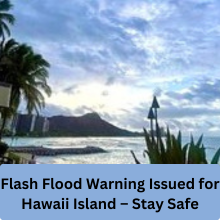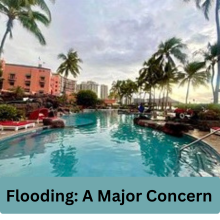
On Tuesday, Hawaii found itself under the grip of heavy rainfall, impacting multiple islands, especially the Big Island. This surge of tropical moisture has prompted flash flood warnings and flood watches across the state, causing concerns about flooding and travel disruptions. Hawaii, known for its sunny beaches and perfect weather, faces intense weather conditions that can rapidly change, putting both locals and visitors on alert.
What’s Happening in Hawaii Right Now?
Heavy rain and thunderstorms continue to batter Hawaii Island, with similar conditions expected to spread across the state. The weather systems have already triggered flash flood warnings for the Big Island and Maui, while a flood watch remains in effect across the region. Rain, ranging from moderate to heavy, is expected to persist throughout Tuesday. The situation is expected to worsen as more rain falls, and with it, the possibility of flooding in low-lying areas grows.
Locations Impacted by Heavy Rain
- Big Island: Particularly vulnerable to flooding due to its diverse geography, including coastal regions and mountainous terrains, the Big Island is experiencing some of the heaviest rainfall. Areas like Hilo, Puna, and Kaʻū are seeing the worst of it, with rainfall reaching up to 4 inches per hour in certain spots.
- Maui: Maui is also under significant rainfall, with local reports indicating heavy showers and concerns for flooding in vulnerable areas. Travelers and residents are advised to stay alert for road closures and other disruptions.
- Oahu and Kauai: While Oahu and Kauai are not as heavily affected as the Big Island, they too will experience rainfall, with conditions expected to worsen by Tuesday. Flash floods and flooding are possible as the moisture from the tropical system moves westward.
Why Is the Rain So Intense?
The heavy rainfall is a result of tropical moisture being funneled toward Hawaii, combined with a weak trough system in the area. A trough is essentially a low-pressure area in the atmosphere that can lead to stormy weather. In this case, the convergence of moisture and instability in the atmosphere has led to significant rain over the islands.
Thunderstorms are also expected, particularly in the Big Island and Maui, as these weather patterns interact with local geography. Hawaii’s mountains and slopes are well-known for enhancing rainfall intensity, turning an ordinary storm into a heavy downpour, which raises concerns for flooding.
Detailed Impact on Hawaii Island
On Hawaii Island, the rain is hitting the southern and eastern portions of the island hardest. Places like Hāmākua, North Hilo, South Hilo, Puna, and Kaʻū have been heavily impacted, with some areas experiencing up to 2 inches of rain per hour. Radar images from the National Weather Service show a clear plume of moisture, which indicates ongoing and expected heavy rainfall.
Flooding: A Major Concern
Flooding is the primary concern for most residents, as runoff from heavy rains could overflow streams and rivers. Low-lying areas, including roads and neighborhoods prone to flooding, could be affected, leading to potential road closures. This is not an unusual situation for Hawaii, but the intensity and duration of the current rain event have raised alarm bells. Urban areas, in particular, are at risk for flash flooding, which can cause significant property damage and disrupt daily life.
Flash Flood Warning Explained
A flash flood warning means that flooding is imminent or already occurring in the affected areas. It is a serious situation that requires immediate attention. People in these areas should move to higher ground, avoid driving on flooded roads, and stay inside until the storm subsides. The National Weather Service is closely monitoring conditions and providing updates on the situation.
Maui’s Struggles with Torrential Rain
Maui is also feeling the brunt of the tropical moisture. Areas along the island’s south and east coasts have experienced heavy rainfall, with some reports indicating that the rain is falling in torrential bursts. Roads are becoming impassable in some areas, and there have been reports of localized flooding.
Oahu and Kauai Prepare for the Rain
While Oahu and Kauai are not yet seeing the worst of the weather, the situation is expected to worsen as the storm system moves westward. Oahu, known for its bustling city life, could face disruptions in public transport, flights, and daily routines as the rain intensifies. Kauai, usually drier, will experience moderate rainfall, with pockets of heavy rain scattered across the island.
The Forecast: What Lies Ahead?
As the storm system moves across Hawaii, a cold front is expected to bring wetter and windier weather later in the week. The cold front, which will progress from Wednesday into Thursday, is likely to stall and dissipate, but not before affecting the islands with gusty winds and more rain.
Also read: FDA Flags Popular Philippine Sauces—Is Your Favorite Affected?
What to Expect Later in the Week
Later in the week, Hawaii residents will experience a period of wet and windy conditions as the cold front moves through the state. The front will bring trade winds, with gusts of 15 to 20 mph. Expect numerous showers, particularly in windward areas, and a few scattered showers in leeward regions. Temperatures will remain mild, with highs between 82°F and 89°F.
The Science Behind Tropical Moisture in Hawaii
Hawaii’s tropical weather is influenced by a variety of atmospheric conditions. Tropical moisture, which originates from the warm Pacific Ocean, can bring intense rainfall when it collides with Hawaii’s mountainous terrain. This collision often leads to heavy showers and storms, particularly on the windward side of the islands.
High-pressure systems to the north and low-pressure systems to the south create a balance in the atmosphere, but when these systems interact, they can increase instability and enhance the likelihood of rain. This combination of atmospheric instability and geography makes Hawaii particularly susceptible to flash floods during heavy storms.
Understanding Weather Terms
- Flash Flood Warning vs Flood Watch: A flash flood warning means that flooding is either occurring or about to occur, while a flood watch means that conditions are favorable for flooding but it’s not guaranteed.
- Thunderstorms and Heavy Rainfall: Thunderstorms occur when warm air rises rapidly, creating conditions for heavy rainfall, lightning, and strong winds. In Hawaii, these storms can be intense due to the combination of tropical moisture and local geography.
How to Stay Safe During Flash Floods
During a flash flood warning, it’s crucial to stay indoors and avoid unnecessary travel. If you’re in a flood-prone area, move to higher ground immediately. Avoid driving through flooded streets as it can be dangerous, and don’t wait for the floodwaters to rise before taking action.
Also read: Mahomes Injured, But Chiefs Win OT Thriller vs. Bucs!
Conclusion
As Hawaii faces intense rainfall and flooding, it’s essential to stay informed and prepared. While the weather is unpredictable, there are steps residents can take to protect themselves and their property. With more rain expected throughout the week, it’s important to remain vigilant and stay updated on weather reports.
FAQs
-
What Should I Do During a Flash Flood Warning in Hawaii?
- Seek higher ground immediately, avoid driving, and stay informed through official channels.
-
How Often Do Floods Happen in Hawaii?
- Flooding can occur frequently during the wet season, especially in coastal and low-lying areas.
-
What Is the Difference Between a Flash Flood Warning and a Flood Watch?
- A flash flood warning indicates imminent flooding, while a flood watch means conditions are favorable for flooding.
-
How Can I Stay Updated on the Latest Weather Conditions in Hawaii?
- Follow local news outlets, NOAA weather alerts, and mobile weather apps for real-time updates.
-
Is it Safe to Travel During a Flash Flood Warning in Hawaii?
- Travel should be avoided during a flash flood warning due to the risks of dangerous road conditions and flooding.
